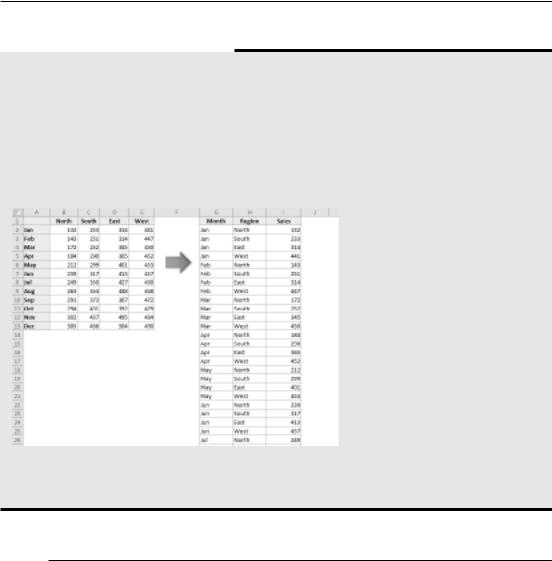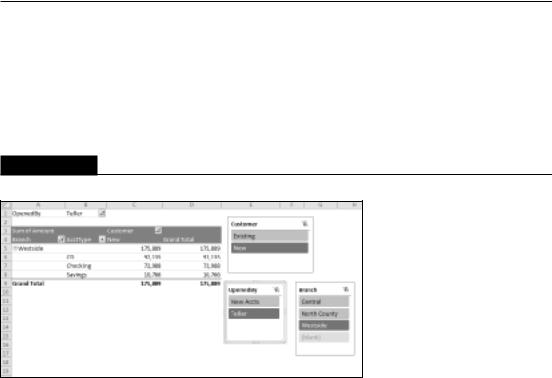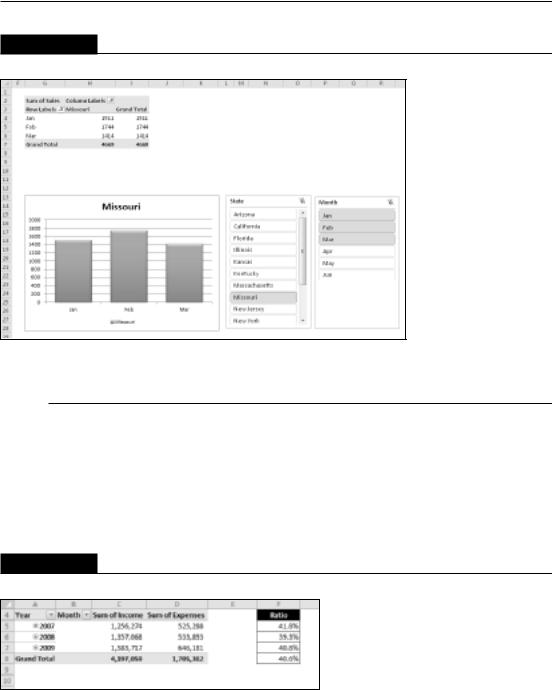
- •About the Author
- •About the Technical Editor
- •Credits
- •Is This Book for You?
- •Software Versions
- •Conventions This Book Uses
- •What the Icons Mean
- •How This Book Is Organized
- •How to Use This Book
- •What’s on the Companion CD
- •What Is Excel Good For?
- •What’s New in Excel 2010?
- •Moving around a Worksheet
- •Introducing the Ribbon
- •Using Shortcut Menus
- •Customizing Your Quick Access Toolbar
- •Working with Dialog Boxes
- •Using the Task Pane
- •Creating Your First Excel Worksheet
- •Entering Text and Values into Your Worksheets
- •Entering Dates and Times into Your Worksheets
- •Modifying Cell Contents
- •Applying Number Formatting
- •Controlling the Worksheet View
- •Working with Rows and Columns
- •Understanding Cells and Ranges
- •Copying or Moving Ranges
- •Using Names to Work with Ranges
- •Adding Comments to Cells
- •What Is a Table?
- •Creating a Table
- •Changing the Look of a Table
- •Working with Tables
- •Getting to Know the Formatting Tools
- •Changing Text Alignment
- •Using Colors and Shading
- •Adding Borders and Lines
- •Adding a Background Image to a Worksheet
- •Using Named Styles for Easier Formatting
- •Understanding Document Themes
- •Creating a New Workbook
- •Opening an Existing Workbook
- •Saving a Workbook
- •Using AutoRecover
- •Specifying a Password
- •Organizing Your Files
- •Other Workbook Info Options
- •Closing Workbooks
- •Safeguarding Your Work
- •Excel File Compatibility
- •Exploring Excel Templates
- •Understanding Custom Excel Templates
- •Printing with One Click
- •Changing Your Page View
- •Adjusting Common Page Setup Settings
- •Adding a Header or Footer to Your Reports
- •Copying Page Setup Settings across Sheets
- •Preventing Certain Cells from Being Printed
- •Preventing Objects from Being Printed
- •Creating Custom Views of Your Worksheet
- •Understanding Formula Basics
- •Entering Formulas into Your Worksheets
- •Editing Formulas
- •Using Cell References in Formulas
- •Using Formulas in Tables
- •Correcting Common Formula Errors
- •Using Advanced Naming Techniques
- •Tips for Working with Formulas
- •A Few Words about Text
- •Text Functions
- •Advanced Text Formulas
- •Date-Related Worksheet Functions
- •Time-Related Functions
- •Basic Counting Formulas
- •Advanced Counting Formulas
- •Summing Formulas
- •Conditional Sums Using a Single Criterion
- •Conditional Sums Using Multiple Criteria
- •Introducing Lookup Formulas
- •Functions Relevant to Lookups
- •Basic Lookup Formulas
- •Specialized Lookup Formulas
- •The Time Value of Money
- •Loan Calculations
- •Investment Calculations
- •Depreciation Calculations
- •Understanding Array Formulas
- •Understanding the Dimensions of an Array
- •Naming Array Constants
- •Working with Array Formulas
- •Using Multicell Array Formulas
- •Using Single-Cell Array Formulas
- •Working with Multicell Array Formulas
- •What Is a Chart?
- •Understanding How Excel Handles Charts
- •Creating a Chart
- •Working with Charts
- •Understanding Chart Types
- •Learning More
- •Selecting Chart Elements
- •User Interface Choices for Modifying Chart Elements
- •Modifying the Chart Area
- •Modifying the Plot Area
- •Working with Chart Titles
- •Working with a Legend
- •Working with Gridlines
- •Modifying the Axes
- •Working with Data Series
- •Creating Chart Templates
- •Learning Some Chart-Making Tricks
- •About Conditional Formatting
- •Specifying Conditional Formatting
- •Conditional Formats That Use Graphics
- •Creating Formula-Based Rules
- •Working with Conditional Formats
- •Sparkline Types
- •Creating Sparklines
- •Customizing Sparklines
- •Specifying a Date Axis
- •Auto-Updating Sparklines
- •Displaying a Sparkline for a Dynamic Range
- •Using Shapes
- •Using SmartArt
- •Using WordArt
- •Working with Other Graphic Types
- •Using the Equation Editor
- •Customizing the Ribbon
- •About Number Formatting
- •Creating a Custom Number Format
- •Custom Number Format Examples
- •About Data Validation
- •Specifying Validation Criteria
- •Types of Validation Criteria You Can Apply
- •Creating a Drop-Down List
- •Using Formulas for Data Validation Rules
- •Understanding Cell References
- •Data Validation Formula Examples
- •Introducing Worksheet Outlines
- •Creating an Outline
- •Working with Outlines
- •Linking Workbooks
- •Creating External Reference Formulas
- •Working with External Reference Formulas
- •Consolidating Worksheets
- •Understanding the Different Web Formats
- •Opening an HTML File
- •Working with Hyperlinks
- •Using Web Queries
- •Other Internet-Related Features
- •Copying and Pasting
- •Copying from Excel to Word
- •Embedding Objects in a Worksheet
- •Using Excel on a Network
- •Understanding File Reservations
- •Sharing Workbooks
- •Tracking Workbook Changes
- •Types of Protection
- •Protecting a Worksheet
- •Protecting a Workbook
- •VB Project Protection
- •Related Topics
- •Using Excel Auditing Tools
- •Searching and Replacing
- •Spell Checking Your Worksheets
- •Using AutoCorrect
- •Understanding External Database Files
- •Importing Access Tables
- •Retrieving Data with Query: An Example
- •Working with Data Returned by Query
- •Using Query without the Wizard
- •Learning More about Query
- •About Pivot Tables
- •Creating a Pivot Table
- •More Pivot Table Examples
- •Learning More
- •Working with Non-Numeric Data
- •Grouping Pivot Table Items
- •Creating a Frequency Distribution
- •Filtering Pivot Tables with Slicers
- •Referencing Cells within a Pivot Table
- •Creating Pivot Charts
- •Another Pivot Table Example
- •Producing a Report with a Pivot Table
- •A What-If Example
- •Types of What-If Analyses
- •Manual What-If Analysis
- •Creating Data Tables
- •Using Scenario Manager
- •What-If Analysis, in Reverse
- •Single-Cell Goal Seeking
- •Introducing Solver
- •Solver Examples
- •Installing the Analysis ToolPak Add-in
- •Using the Analysis Tools
- •Introducing the Analysis ToolPak Tools
- •Introducing VBA Macros
- •Displaying the Developer Tab
- •About Macro Security
- •Saving Workbooks That Contain Macros
- •Two Types of VBA Macros
- •Creating VBA Macros
- •Learning More
- •Overview of VBA Functions
- •An Introductory Example
- •About Function Procedures
- •Executing Function Procedures
- •Function Procedure Arguments
- •Debugging Custom Functions
- •Inserting Custom Functions
- •Learning More
- •Why Create UserForms?
- •UserForm Alternatives
- •Creating UserForms: An Overview
- •A UserForm Example
- •Another UserForm Example
- •More on Creating UserForms
- •Learning More
- •Why Use Controls on a Worksheet?
- •Using Controls
- •Reviewing the Available ActiveX Controls
- •Understanding Events
- •Entering Event-Handler VBA Code
- •Using Workbook-Level Events
- •Working with Worksheet Events
- •Using Non-Object Events
- •Working with Ranges
- •Working with Workbooks
- •Working with Charts
- •VBA Speed Tips
- •What Is an Add-In?
- •Working with Add-Ins
- •Why Create Add-Ins?
- •Creating Add-Ins
- •An Add-In Example
- •System Requirements
- •Using the CD
- •What’s on the CD
- •Troubleshooting
- •The Excel Help System
- •Microsoft Technical Support
- •Internet Newsgroups
- •Internet Web sites
- •End-User License Agreement

Chapter 35: Analyzing Data with Pivot Tables
A Reverse Pivot Table
The Excel Pivot Table feature creates a summary table from a list. But what if you want to perform the opposite operation? Often, you may have a two-way summary table, and it would be convenient if the data were in the form of a list.
In the figure here, range A1:E13 contains a summary table with 48 data points. Notice that this summary table is similar to a pivot table. Column G:I shows part of a 48-row table that was derived from the summary table. In other words, every value in the original summary table gets converted to a row, which also contains the region name and month. This type of table is useful because it can be sorted and manipulated in other ways. And, you can create a pivot table from this transformed table.
The companion CD-ROM contains a workbook, reverse pivot.xlsm, which has a macro that will convert any two-way summary table into a three-column normalized table.
Filtering Pivot Tables with Slicers
A Slicer is an interactive control that makes it easy to filter data in a pivot table. Figure 35.20 shows a pivot table with three Slicers. Each Slicer represents a particular field. In this case, the pivot table is displaying data for New customers, opened by tellers at the Westside branch.
731

Part V: Analyzing Data with Excel
New Feature
Slicers are new to Excel 2010. n
The same type of filtering can be accomplished by using the field labels in the pivot table, but Slicers are intended for those who might not understand how to filter data in a pivot table. Slicers can also be used to create an attractive and easy-to-use interactive “dashboard.”
FIGURE 35.20
Using Slicers to filter the data displayed in a pivot table.
To add one or more Slicers to a worksheet, start by selecting any cell in a pivot table. Then choose Insert Filter Slicer. The Insert Slicers dialog box appears, with a list of all fields in the pivot table. Place a check mark next to the Slicers you want, and then click OK.
Slicers can be moved and resized, and you can change the look. To remove the effects of filtering by a particular Slicer, click the icon in the Slicer’s upper-right corner.
To use a Slicer to filter data in a pivot table, just click a button. To display multiple values, press Ctrl while you click the buttons in a Slicer.
Figure 35.21 shows a pivot table and a pivot chart. Two Slicers are used to filter the data (by state and by month). In this case, the pivot table (and pivot chart) shows only the data for Missouri for the months of January through March. Slicers provide quick and easy way to create an interactive chart.
On the CD
This workbook, named pivot chart slicer.xlsx, is available on the companion CD-ROM. n
732

Chapter 35: Analyzing Data with Pivot Tables
FIGURE 35.21
Using Slicers to filter a pivot table by state and by month.
Referencing Cells within a Pivot Table
After you create a pivot table, you may want to create a formula that references one or more cells within a pivot table. Figure 35.22 shows a simple pivot table that displays income and expense information for three years. In this pivot table, the Month field is hidden, so the pivot table shows the year totals.
On the CD
This workbook, named income and expenses.xlsx, is available on the companion CD-ROM. n
FIGURE 35.22
The formulas in column F reference cells in the pivot table.
733

Part V: Analyzing Data with Excel
Column F contains formulas, and this column is not part of the pivot table. These formulas calculate the expense-to-income ratio for each year. I created these formulas by pointing to the cells. You may expect to see this formula in cell F5:
=D5/C5
In fact, the formula in cell F5 is
=GETPIVOTDATA(“Sum of Expenses”,$A$3,”Year”,2007)/GETPIVOTDATA
(“Sum of Income”,$A$3,”Year”,2007)
When you use the pointing technique to create a formula that references a cell in a pivot table, Excel replaces those simple cell references with a much more complicated GETPIVOTDATA function. If you type the cell references manually (rather than pointing to them), Excel does not use the
GETPIVOTDATA function.
The reason? Using the GETPIVOTDATA function helps ensure that the formula will continue to reference the intended cells if the pivot table layout is changed. Figure 35.23 shows the pivot table after expanding the years to show the month detail. As you can see, the formulas in column F still show the correct result even though the referenced cells are in a different location. Had I used simple cell references, the formula would return incorrect results after expanding the years.
Caution
Using the GETPIVOTDATA function has one caveat: The data that it retrieves must be visible. If you modify the pivot table so that the value returned by GETPIVOTDATA is no longer visible, the formula returns an error. n
Tip
If, for some reason, you want to prevent Excel from using the GETPIVOTDATA function when you point to pivot table cells when creating a formula, choose PivotTable Tools Options PivotTable Options Generate GetPivot Data. (This command is a toggle.) n
734
